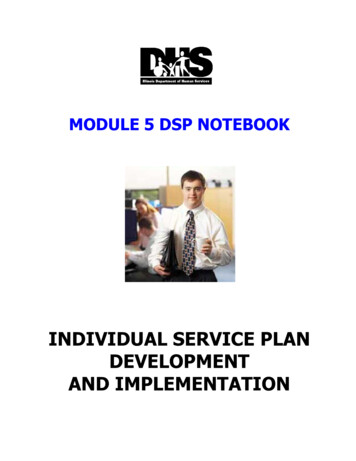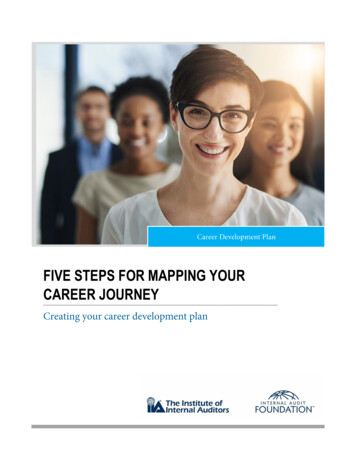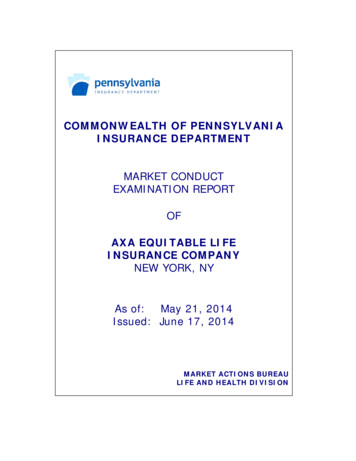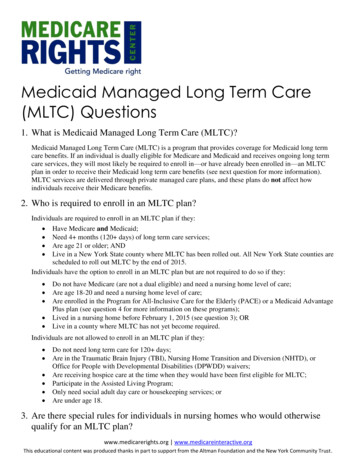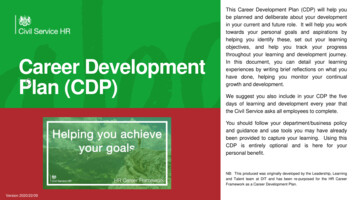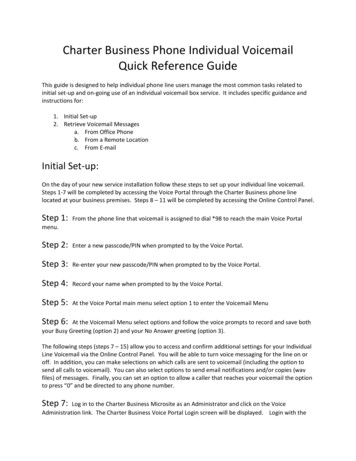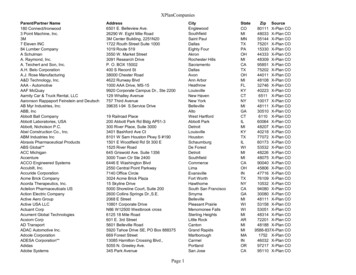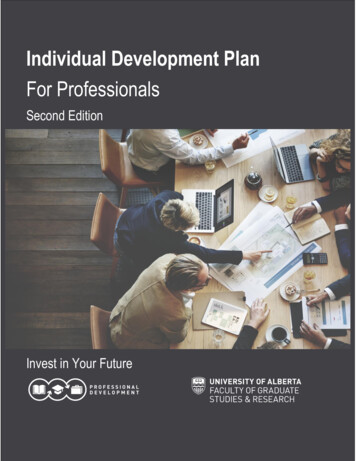
Transcription
Individual Development PlanFor ProfessionalsSecond EditionInvest in Your Future
Table of ContentsTable of Contents . 1Background . 2Why a PD Requirement?. 2Overview of the PD Requirement . 3What is an Individual Development Plan? . 4Steps for Completing Your IDP. 4Overview of the Eight Hours of PD Activities. 4Before You Begin: Top Tips for Your IDP and Beyond . 5IDP Step 1: Ideas Generation . 6IDP Step 2: Self-Assessment . 7Rating your skills and competencies. 8Types of Skills and Competencies . 8IDP Step 3: Career Planning . 22Choosing Three Career Goals. 25Mapping Your Eight Hours of PD Activities. 28IDP Step 4: Timeline . 30IDP Step 5: Review . 35Second Edition written and designed by Deanna Davis, PhD, Professional Development Instructional Design Specialistand Program Lead, Graduate Teaching and Learning Program, Faculty of Graduate Studies and ResearchThis work is licensed under a Creative Commons Attribution-NonCommercial 4.0 International License (CC BY-NC 4.0).You are free to:Share — copy and redistribute the material in any medium or format Adapt —remix, transform, and build upon the materialUnder the following terms:Attribution — You must give appropriate credit, provide a link to the license, and indicate if changes were made. Youmay do so in any reasonable manner, but not in any way that suggests the licensor endorses you or your use.NonCommercial — You may not use the material for commercial purposes.Please Note: Graduate students are required tocomplete the University of Alberta ProfessionalDevelopment Requirement, which includes theIndividual Development Plan (IDP) and eight hours ofprofessional development activities. (Mandatory forstudents admitted September 2016 and onwards.)For more information, contact the ProfessionalDevelopment Team: grad.pd@ualberta.ca1 Page
Professional Development RequirementIndividual Development Plan for ProfessionalsBackgroundAfter consultation with the Graduate Students’ Association andconsideration of economic job trends, the University of Alberta is the firstCanadian university to implement the Professional Development (PD)Requirement (following some of the Ivy League colleges in the UnitedStates).It is an exciting initiative to help you recognize your talents, pursue yourinterests, learn professional skills and make the connections that will helpyou excel in your chosen field. Although it is mandatory for all incominggraduate students, some departments have professional developmentalready incorporated into their programs. Please check with yourdepartment to confirm how this requirement is fulfilled in your program.Why a PD Requirement?The IDP offers you an opportunity to think about your professional goals in a structured and supported manner. It is achance to think about where you want to be when you complete your degree and how you will complement thedisciplinary knowledge you develop through in your program with skills and competencies that will set you on a pathto achieving your professional goals. These goals may change during the course of your program.Identifying professional development activities is part of the IDP process. The pursuit of professional development is alifelong activity that professionals in all stages of their careers pursue. Your professional development needs will varyfrom other students depending on your background, discipline, and professional goals. The PD Requirement and itscomponents (IDP and eight hours of professional development activities) are flexible and allow you to tailor therequirement to your individual needs. This IDP workbook will help you clarify your career goals, choose useful PDactivities, and meet your academic requirements so you are well equipped to achieve your career goals.Professional development is the active acquisition of skills, knowledge, and mindset to realize one’s strength andpotential in all environments. It sets up individuals for success in achieving their goals while giving them the abilityto meet, exceed and adapt to personal, career and societal responsibilities within the context of a changing world.2 Page
Overview of the PD RequirementGettingStartedDeadlinesThe PD Requirement has two components: 1) the completion of the IDP, and 2) eight hours ofprofessional development activities. While work on your IDP cannot be counted as part of theeight-hour professional development requirement, it is designed to complement other PDactivities. The three-part IDP Series can guide the completion of your IDP and can help youprepare to review it with your supervisor and/or career mentor. With the approval of yourdepartment, Parts 2 and 3 of the IDP series may count towards your eight hours of PD activities.For distance learners or those that find it challenging to attend in-person workshops, the IDPOnline Workshop can support your career planning. As you complete your IDP, ensure that youhave set aside sufficient time to think deeply about where you want your degree to take you,the skills and competencies you already possess as well as those you want to develop. Finally,take the time to think carefully about your timeline for program completion and professionaldevelopment activities, as it will help support timely degree completion.To help you take advantage of internships and other great professional opportunities availableon campus your IDP must be finalized and reviewed by your supervisor or career mentor bycertain deadlines depending on your academic program.Professional Development RequirementIndividual Development Plan (IDP)Completed and reviewed by yoursupervisor/career mentor within: 12 months of your program’scommencement for full-timemaster’s student 24 months of your program’scommencement for part-timemaster’s students 18 months of your program’scommencement for full-timedoctoral student 36 months of your program’scommencement for part-timedoctoral studentsEight Hours of PD ActivitiesCompleted and reviewed by yoursupervisor/career mentor within: 12 months of your program’scommencement for full-timemaster’s student24 months of your program’scommencement for part-timemaster’s students18 months of your program’scommencement for full-timedoctoral student36 months of your program’scommencement for part-timedoctoral students3 Page
What is an Individual Development Plan?An Individual Development Plan (IDP) is a professional development toolused to help an individual identify strengths and areas for growth, and setattainable goals. As an experienced professional, you probably haveexperience with creating an IDP as they are a standard practice in theworkplace and have long been used as a career-planning tool in industry,government and education.When IDPs moved into the academic arena, postdoctoral fellows andgraduate students found they were more productive, more satisfied withtheir experience, and had fewer supervisory conflicts. Creating an IDP willhelp you prepare for work in academic and non-academic careers.Steps for Completing Your IDPProfessional development is part ofthe IDP process and is a lifelongactivity that professionals in all stagesof their careers pursue. While yourprofessional development needs maydiffer from those just beginning theircareers, they are importantnonetheless. This IDP workbook willhelp you clarify your career goals,choose useful PD activities, and meetyour academic requirements so youare well equipped to achieve yourcareer goals.Your IDP is an opportunity to setyou on a path to achieving yourprofessional goals.It is recommended that you update your IDP annually. As you movethrough your program your skills and competencies will grow, and yourprofessional aspirations will evolve based on new opportunities that emerge. Regularly taking into account other factorsthat influence your career management such as shifting priorities and personal circumstances will also assist in ensuringthat you are preparing well for your professional goals.The IDP has four main components and a recommended annual review. Each step is explained in detail as you movethrough the workbook.Overview of the Eight Hours of PD ActivitiesWhen it comes to the eight hours of PD Activities, the PD Requirement isintentionally flexible to allow you to tailor your activities to your individualneeds, disciplinary context, previous work experience, and professionalaspirations. This means that the eight hours of PD Activities will vary greatlyfrom student to student because it is tailored to YOU. As you complete yourIDP, think about the types of professional development opportunities andworkshops that will support the skills and competencies you want todevelop. A professional development activity fulfils the requirement if itcontributes to the acquisition of skills, knowledge, and mindset, andincludes ALL of the following three components: When mapping your eight hours ofPD Activities, think about the thingsyou may already be doing in yourprofessional life. Professionaldevelopment activities completedin the context of your work life maycounts towards your PDRequirement.Comprises of formal training or active learning with an assessment component (self-assessment, reflection,quiz, write-pair-share, evidence of knowledge application)Falls outside of research methods training, capstone project, thesis or equivalent, and required practicumSupports the career goals and/or seven skills/competencies identified in the individual development plan.4 Page
Before You Begin: Top Tips for Your IDP and Beyond1. Take adequate time. It can take more than a day to explore fully your career goals. Follow current trendsabout job markets. Keep an open mind about various career paths and position yourself for a transition intomultiple career paths. Recognize your career directions may also change over time as new opportunitiesemerge, your interests shift, and your personal commitments change. Also, remember that career is aboutboth paid and unpaid experience, formal and informal learning, and leisure activities. All of your activitiespositively affect your career.2. Take action, reflect, and rest. Take action, reflect, and rest. It is important to be productive in your programand to make good use of your time. It is also important, though, to reflect on what you have learned andhow it might impact your next steps. Taking time to rest is also important to ensure that you are attendingto self-care. Developing the habits of taking time to reflect and rest will set you up for healthy careermanagement.3. Career exploration is continuous. Career exploration is a lifelong skill that builds over time. Use your IDPworkbook to keep an ongoing list of options that are attractive to you and continue to task small, low riskactions to test whether those options are a good fit. These actions will build skills, experiences, andconnections that you can leverage if and when needed. The PD Requirement offers this kind of opportunitythrough both career exploration and the eight hours of PD activities.4. Build meaningful connections. Career management is in part about the practice of building meaningfulconnections over time rather than attending one or two networking sessions. Take time to developmeaningful connections with people within and outside your research area. There are ways to be of serviceto the university and to the broader community while creating new connections and skills.5. Formal education is one piece of the academic journey. Remember that your formal education is just onepiece of what future employers are looking for. Employers hire people who have the right combination ofeducation, skills/competencies, and related experience. Invest in your future by taking time to buildskills/competencies and experiences.6. Practice consistent communication. Understand your supervisor's expectations and share your own. Providea schedule of what you hope to accomplish in the short and long term and by meeting regularly with yoursupervisor/committee you will demonstrate your progress.7. Manage Up: Your supervisor may need your support in supporting you! Provide your supervisor with links tosupport materials for the IDP so that they are also well prepared for your IDP conversation. Let yoursupervisor know what would help you to be effective in your program. Keep notes of your meetings andshare them with your supervisor so you both have a clear understanding of next steps and expectations.I keep coming back to my IDP because I learn something new about myself every time. - Graduate StudentReviewing students’ IDPs helps me be a better mentor. –Graduate Student Supervisor5 Page
IDP Step 1: Ideas GenerationAs a first step in creating your IDP, think about the things you like do, the things you are alreadygood at and what is important to you in your career. This is will help you think about careerpaths that are a good fit (Step 2), and to evaluate opportunities that emerge. It is also good toknow what you do not want in your next opportunity, job or position.TIPS1. Stay Open and Take Time: Avoid using job titles or labels and focus on activities that you want and behavioursyou want to engage in. Suspend judgment about what it practical and feasible. Give yourself time tobrainstorm!2. Look at the idea of “career” broadly: Your career is NOT just activities that include paid work. Whendeveloping your IDP, think about the "career" in broad terms. Career is the sum of ALL experiences, includingpaid and unpaid work, formal and informal learning, and leisure activities throughout life.What do I hope to create?What or who do I hope to inspire?What social issues do I feel passionate about and want to help support or change?6 Page
What are my hobbies and interests?What are my strengths?What are areas for growth?IDP Step 2: Self-AssessmentThere are seven skills and attributes employers look for in potential employees and that alumni have identified as beinghelpful in their life after U of A: communication, critical thinking, creativity, collaboration, confidence, scholarship andethical responsibility. The self-assessment component of the IDP uses these seven skills and competencies to help youarticulate your graduate school experiences into skills and competencies required in the career goals you will identifylater in your IDP. This will help you identify areas for growth during your graduate program.Taking the time to think carefully about how your experiences have supported the development of skills andcompetencies is an important part of career management. In this section, you will evaluate your skills and competenciesacross seven IDP areas. As part of your self-assessment you will think of specific examples where you havedemonstrated workplace skills/competencies.As you complete your self-assessment, make note of the activities/workshops and actions you can build into yourtimeline to develop your skills and competencies.7 Page
Rating your skills and competenciesThroughout this section, you will reflect on your skills and competencies, particularly as they relate to your chosen careergoals and aspirations. You will use the criteria below. As you rate your skills and competencies, think about evidence ofyour rating. If you have given yourself a strong rating, what are examples of situations where you have demonstrated thisskill or competency? If you have identified an area of growth, what leads you to believe that you need to develop this skillor competency?RatingDescriptor1Yet to be Developed: You have no experience with this skill/competency.2Developing: You have started to develop your skill/competency in this area, but your proficiency islimited or you have no applied experience. With coaching, you are able to demonstrate this skill insimple situations.34Proficient: You have a developed understanding of and experience with this skill/competency, and youare able to apply it in both predictable and new situations.Highly Effective: You demonstrate a broad and deep understanding of this skill/competency and havesubstantial experience in the area. You are able to apply this skill/competency regularly andindependently, and display it in complex and varied situations. You are a role model for thisskill/competency.Types of Skills and CompetenciesTechnical Skills: Technical skills are developed through education, professional training and work experience. Examplesinclude using computer software, specialized equipment, programming.Personal Skills: Interpersonal skills and tactics used to interact with others. Examples include diplomacy, independenceand motivation.Transferable Skills: Transferable skills may be learned in one context, but can be applied in multiple contexts. Examplesof transferable skills include teamwork, leadership, communication, decision making, and critical thinking.8 Page
TIPS1. Use the self-assessment to identify about areas for growth: For each competency, you will assess important skillsand competencies used in academic and non-academic workplaces. Your self-assessment will help you identify yourstrengths as well as areas you would like to develop further with your eight hours of PD Activities. This informationwill also be very important as you determine potential career goals in Step 3.2. Use evidence to gauge your skills and competencies: Generate examples about where, how, and at what level youhave demonstrated these skills and competencies. This will be very useful as you begin to develop your resumeand/or curriculum vitae. It could also be useful for an interview and networking opportunities. Examples can bedrawn from your experiences in your graduate program and other types of formal training as well as your volunteer,leisure and previous work experiences.3. The importance of any given skill or competency can vary depending on where your career takes you:Remember that while all the skills and competencies explored in the IDP are important in academic and nonacademic workplaces, aspects of these skills and competencies have different degrees of importance dependingon where your career will take you.2a: CreativityCreativity is closely tied to critical thinking and it impacts the extent to which you to pushdisciplinary boundaries, solve problems effectively, and “think outside the box.” Creativethinking is also about your ability to balance logical thinking with creative energies. This balanceallows your ideas to be developed, reimagined and marketed, or which easily lends itself toentrepreneurial thinking and innovation.Rate your current creativity skills/competencies on a scale of one to four:1—Yet to be developed2—DevelopingAbility to:Rating3—Proficient4—Highly effectiveEvidenceProblem solve using newsolutions/approachesVerify workability of creative ideasDevelop and implement creativeideasInnovate by questioning,experimenting and networking9 Page
Collaborate creatively within a teamMake connections among diverseideasBalance logical and creative thinking“Think on your feet”“Think outside of the box”Pose new research questionsPush disciplinary boundariesAnswering questions at conferencesLink ideas to new services andproductsLink my skills, competencies, andinterests to emerging opportunities10 P a g e
2b: CommunicationAn ability to communicate in a variety of contexts, with different audiences, and across cultures isessential skills in your professional life. This means communicating clearly and assertively, whiledemonstrating emotional intelligence and good listening habits. Communicating your ideas isessential in any entrepreneurial endeavour. Professional networking skills and exhibitingprofessional etiquette are also essential to your career success.Rate your current creativity skills/competencies on a scale of one to four:1—Yet to be developed2—DevelopingAbility to:Rating3—Proficient4—Highly effectiveEvidence for my ratingWrite for a general audienceWrite for a discipline specificaudienceGive an oral presentation for ageneral audienceGive an oral presentation for adiscipline specific audienceCommunicate your expertise to ageneral audienceCommunicate your expertise to adiscipline specific audienceAnswer questions in a variety ofcontextsExpress complex ideas in anaccessible form11 P a g e
Effectively use multimediacommunicationDemonstrate knowledge ofworkplace/professional etiquetteNetwork in academic circlesNetwork in non-academic circlesCommunicate cross-culturallyCommunicate assertivelyCommunicate with emotionalintelligence (empathy, respect, selfawareness)Demonstrate active listening skillsPitch an idea to a general audienceCommunicating your personalbrand12 P a g e
2c: ConfidenceSelf-confidence drives all other competencies and has a direct impact on your career success. Yourwillingness to self-reflect, take risks and decisive action, and be self-directed are all indicators ofyour confidence. Perseverance and resilience are critical components in the development ofconfidence.Rate your current creativity skills/competencies on a scale of one to four:1—Yet to be developed2—DevelopingAbility to:Rating3—Proficient4—Highly effectiveEvidence for my ratingPursue a project to completion withminimal supervisionWork independently, self-manageand be self- awareTake initiativeThink and act decisively, and initiatea course of actionDemonstrate perseverance andresilience followingchallenges/failuresChampion yourself and othersAct as a role model for othersTake on a leadership roleLead from where you areTake on an entrepreneurial roleIdentify personal strengths andweaknessesTo take professional feedbackobjectively13 P a g e
Take service initiative in thecommunityDemonstrate resilience in the faceof challenges/setbacks/failureLink your skills, competencies, andinterests to emerging opportunitiesTake initiative to bring about positivechange in academic, professional, andpersonal contexts.2d: ScholarshipWhether it is in a course paper, presentation, capstone project, or thesis, scholarship bringstogether diverse skills that demonstrate your capacity to locate, interpret, and manageinformation. Scholarship is about not only your ability to develop a deep knowledge and broadscope of your subject field, but also your ability to generate and share knowledge with theacademic community and public. For some, this can be applied to researching the market needsof a product or services, as required in entrepreneurship.Rate your current creativity skills/competencies on a scale of one to four:1—Yet to be developed2—DevelopingAbility to:Rating3—Proficient4—Highly effectiveEvidence for my ratingDemonstrate general research skillsDemonstrate discipline specificresearch skillsConvey breadth and depth of yourdiscipline to a lay audienceManage informationLocate, evaluate, and useinformation effectively14 P a g e
Demonstrate an understanding ofthe publication submission/peerreview processGenerate and share new knowledgeDemonstrate the scope and depthof knowledge to pitch your ideas(proposal)Manage budgets and/or resourcesWrite grant proposals for differenceaudiencesDemonstrate academic writing skillsDevelop a business planTIPThe Three-Minute Thesis competition is a great way to develop your abilityto share the importance of your research with a non-disciplinary audience.Visit uab.ca/gradpd for more information.15 P a g e
2e: Ethical ResponsibilityYour ability to conduct yourself with ethical responsibility is inextricably linked to all the skillsyou bring to your professional life. To act ethically means conducting yourself in a principledway, not only by observing specific codes of behavior, but also by acknowledging others’ work,carrying out ethical research, separating your personal and professional lives, anddemonstrating good use of your time. Ethical responsibility is about demonstrating civic andsocial responsibility by sharing your research with society and advocating for the needs ofothers, a consideration required in entrepreneurship.Rate your current creativity skills/competencies on a scale of one to four:1—Yet to be developedAbility to:2—DevelopingRating3—Proficient4—Highly effectiveEvidence for my ratingIdentify conflicts of interestGive due credit to othersMaintain confidentialitySeparate your personal andprofessional livesManage time effectively andprioritize workloadConduct yourself with personalaccountabilityConduct research ethically16 P a g e
Maintain integrity in research datarepresentationConvey the importance of yourresearch relative tosocial/environmental awarenessand global citizenshipDemonstrate civic and socialresponsibilityAdvocate for your researchAdvocate for people and needs ofothersCommunicate assertivelyConduct yourself according to theinformal/formal discipline-specificcodes of behaviorUnderstanding the cultural ,psychological, and behaviouralaspects of conflictDemonstrate workplace behavioursthat highlight the value of equity,diversity and inclusion (EDI)Demonstrate workplace behavioursthat support the work of Truth andReconciliation17 P a g e
2f: Critical ThinkingThe ability to collaborate, assume different roles within the team environment, and buildworking relationships is crucial professional skills. Your ability to give and receive constructivefeedback, have difficult conversations, and resolve conflicts are an essential part ofcollaboration.Entrepreneurship relies heavily on interacting with others, from networking to resolvingtechnical issues.Rate your current creativity skills/competencies on a scale of one to four:1—Yet to be developed2—DevelopingAbility to:Rating3—Proficient4—Highly effectiveEvidence for my ratingBe flexible in your thinking andexplore alternate viewsRecognize and define a problemThink strategically and anticipateopportunities and challengesIdentify and challenge personal/discipline assumptions, biases, andprejudicesAsk clearly defined questionsInterpret information from a varietyof approachesDeconstruct idea and identify therelationships among thecomponentsCritique arguments and showstrengths and weaknessesRecommend the next stepsfor a project18 P a g e
Reframe complex knowledge to besuitable for social media and othercommunication formatsSee how new ideas can createopportunitiesWrite reviewsFind applications for your research19 P a g e
2g: Collaboration:The ability to collaborate, assume different roles within the team environment, and build workingrelationships is crucial professional skills. Your ability to give and receive constructive feedback,have difficult conversations, and resolve conflicts are an essential part of collaboration.Entrepreneurship relies heavily on interacting with others, from networking to resolving technicalissues.Rate your current creativity skills/competencies on a scale of one to four:1—Yet to be developed2—DevelopingAbility to:Rating3—Proficient4—Highly effectiveEvidence for my ratingCollaborate across disciplinesCollaborate with people of differenteducational backgroundsCollaborate in a multiculturalenvironmentProvide constructive feedbackReceive and act upon constructivefeedbackCompromise and balancecompeting needsBuild and maintain meaningfulrelationshipsEstablish definitions and agreementon the role of partners incollaborative work or a teamenvironmentFacilitate discussion in acollaborative or team settingTake on different roles in a teamsetting20 P a g e
Participate in, or lead, team buildingRecognize and respect thecontribution of collaboratorsHave difficult conversationsShare necessary information withcollaborators/team to carry outtasksIdentify obstacles and addressproblems when workingcollaboratively or in a team settingTake responsibility formistakes/
Identifying professional development activities is part of the IDP process. The pursuit of professional development is a lifelong activity that professionals in all stages of their careers pursue. Your professional development needs will vary from other students depending on your backgro

